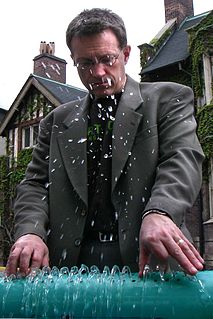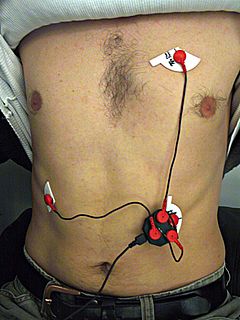
Neurofeedback (NFB), also called neurotherapy or neurobiofeedback, is a type of biofeedback that uses real-time displays of brain activity—most commonly electroencephalography (EEG)—in an attempt to teach self-regulation of brain function. Typically, sensors are placed on the scalp to measure electrical activity, with measurements displayed using video displays or sound. There is significant evidence supporting neurotherapy for generalized treatment of mental disorders and has been practiced over four decades, although never gaining prominence in the medical mainstream. NFB is relatively non-invasive and is administered as a long term treatment option, typically taking a month to complete. It is estimated over 15,000 clinicians, world-wide are using this technology.
A brain–computer interface (BCI), sometimes called a neural control interface (NCI), mind–machine interface (MMI), direct neural interface (DNI), or brain–machine interface (BMI), is a direct communication pathway between an enhanced or wired brain and an external device. BCIs are often directed at researching, mapping, assisting, augmenting, or repairing human cognitive or sensory-motor functions.
The Logos Foundation is a professional artistic organisation founded in 1968. It focuses on the promotion of new musics and audio related arts by means of new music production, concerts, performances, composition, technological research projects and other contemporary music related activities.
Alpha waves are neural oscillations in the frequency range of 8–12 Hz likely originating from the synchronous and coherent electrical activity of thalamic pacemaker cells in humans. Historically, they are also called "Berger's waves" after Hans Berger, the inventor of EEG.
Brainwave entrainment, also referred to as brainwave synchronization and neural entrainment, refers to the hypothesized capacity of the brain to naturally synchronize its brainwave frequencies with the rhythm of periodic external stimuli, most commonly auditory, visual, or tactile.

Erkki Juhani Kurenniemi was a Finnish designer, philosopher and artist, best known for his electronic music compositions and the electronic instruments he has designed. He is considered to have been one of the leading early pioneers of electronic music in Finland. Kurenniemi was also a science populariser, a futurologist, a pioneer of media culture, and an experimental film-maker.

Eduardo Reck Miranda is a Brazilian composer of chamber and electroacoustic pieces but is most notable in the United Kingdom for his scientific research into computer music, particularly in the field of human-machine interfaces where brain waves will replace keyboards and voice commands to permit the disabled to express themselves musically.
Hemi-Sync is a trademarked brand name for a patented process used to create audio patterns containing binaural beats, which are commercialized in the form of audio CDs. Interstate Industries Inc., created by Hemi-Sync founder Robert Monroe, is the owner of the Hemi-Sync technology.

An experimental musical instrument is a musical instrument that modifies or extends an existing instrument or class of instruments, or defines or creates a new class of instrument. Some are created through simple modifications, such as cracked drum cymbals or metal objects inserted between piano strings in a prepared piano. Some experimental instruments are created from household items like a homemade mute for brass instruments such as bathtub plugs. Other experimental instruments are created from electronic spare parts, or by mixing acoustic instruments with electric components.
A biosignal is any signal in living beings that can be continually measured and monitored. The term biosignal is often used to refer to bioelectrical signals, but it may refer to both electrical and non-electrical signals. The usual understanding is to refer only to time-varying signals, although spatial parameter variations are sometimes subsumed as well.
Brain-reading or thought identification uses the responses of multiple voxels in the brain evoked by stimulus then detected by fMRI in order to decode the original stimulus. Advances in research have made this possible by using human neuroimaging to decode a person's conscious experience based on non-invasive measurements of an individual's brain activity. Brain reading studies differ in the type of decoding employed, the target, and the decoding algorithms employed.
NeuroSky, Inc. is a manufacturer of Brain-Computer Interface (BCI) technologies for consumer product applications, which was founded in 2004 in Silicon Valley, California. The company adapts electroencephalography (EEG) and electromyography (EMG) technology to fit a consumer market within a number of fields such as entertainment, education, automotive, and health.
Biomusic is a form of experimental music which deals with sounds created or performed by non-humans. The definition is also sometimes extended to include sounds made by humans in a directly biological way. For instance, music that is created by the brain waves of the composer can also be called biomusic as can music created by the human body without the use of tools or instruments that are not part of the body.

An electrocardiophone and cardiophone is a musical instrument or diagnostic tool which uses heart waves to generate or modulate sounds.

Electroencephalography (EEG) is an electrophysiological monitoring method to record electrical activity of the brain. It is typically noninvasive, with the electrodes placed along the scalp, although invasive electrodes are sometimes used, as in electrocorticography, sometimes called intracranial EEG.
Mindflex is a toy by Mattel which apparently uses brain waves to steer a ball through an obstacle course. The brain waves are captured with the enclosed EEG headset, which allows the user to control an air stream with their concentration, thus lifting or lowering the delicate foam ball. The game was released in the fall of 2009.
Alexis Kirke is a composer and filmmaker known for his interdisciplinary practice. He has been called "the Philip K. Dick of contemporary music". Alexis is British and lives in Plymouth, in South West England. Alexis says he takes his inspiration from both the Arts and from Science/Technology – and has two doctorates – one from each of those Faculties at Plymouth University. In particular, his highest profile work has been motivated by interests in quantum mechanics, marine science, stock markets, and artificial intelligence. Alexis is senior research fellow at the Interdisciplinary Centre for Computer Music Research at the Plymouth University, and is composer-in-residence for the Plymouth Marine Institute.
Imagined speech is thinking in the form of sound – “hearing” one’s own voice silently to oneself, without the intentional movement of any extremities such as the lips, tongue, or hands. Logically, imagined speech has been possible since the emergence of language, however, the phenomenon is most associated with the signal processing and detection within electroencephalograph (EEG) data as well as data obtained using alternative non-invasive, brain–computer interface (BCI) devices.

The Aesthetic Research Centre (A.R.C.) was a Canadian publisher of academic books, scientific journals, LP recordings and graphic scores in the field of sound sculpture, Avant-garde music and process music, as well as neurofeedback in the arts.
Richard Charles Boulanger is a composer, author, and electronic musician. He is a key figure in the development of the audio programming language Csound, and is associated with computer music gurus Max Mathews and Barry Vercoe.










